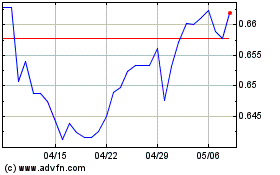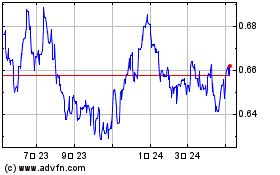UK Q3 Record GDP Growth Exceeds Estimate
2020年12月22日 - 11:59AM
RTTF2
The UK economy rebounded at a faster than estimated pace in the
third quarter, reflecting the effects of the easing of lockdown
restrictions and also some recovery of activity from the steep
contraction in April, the Office for National Statistics said
Tuesday.
Gross domestic product grew by a record 16 percent sequentially
instead of 15.5 percent expansion estimated previously. GDP had
fallen by revised 18.8 percent in the second quarter.
Although this reflects some recovery of activity following the
record contraction in the second quarter, GDP was 8.6 percent below
where it was at the end of 2019.
The annual fall in GDP was revised to 8.6 percent from 9.6
percent in the third quarter.
Data showed that the cumulative fall in GDP in the first half of
2020 was 21.2 percent compared with the previous estimate of a 21.8
percent cumulative fall.
While a double-dip recession is a clear possibility if the Tier
4 Covid-19 restrictions are extended into 2021, the third quarter's
high saving rate provides optimism that as long as vaccines are
effective and widespread, GDP will stage a strong rebound in the
second half of next year, Ruth Gregory, an economist at Capital
Economics, said.
The households' saving ratio came in at 16.9 percent compared
with 27.4 percent in the second quarter.
The quarterly increases in services, production and construction
output in were the largest on record in the third quarter.
Services output grew by a revised 14.7 percent and production
output advanced by a revised 14.7 percent, and construction output
surged by a revised 41.2 percent.
The expenditure-side breakdown showed that the recovery in
private consumption, government spending and gross capital
formation was in line with the easing of public health
restrictions.
Household consumption increased by 19.5 percent driven by higher
spending on restaurants and hotels, and transport. Due to higher
spending on health and education, government consumption advanced
10.4 percent.
Gross fixed capital formation increased by revised 17.9 percent
and business investment grew 9.4 percent.
The UK posted a trade surplus of 0.2 percent of nominal GDP,
which was a downward revision from the first estimate of a trade
surplus of 0.9 percent of GDP.
In November, the budget deficit excluding public sector banks
rose to the third highest level since records began in 1993, the
ONS said in a separate communiqué.
Public sector net borrowing excluding banks widened by GBP 26
billion from the last year to GBP 31.6 billion in November. This
was the highest November borrowing and the third-highest borrowing
in any month since monthly records began in 1993.
During April to November, public sector net borrowing surged GBP
188.6 billion to GBP 240.9 billion, the highest borrowing in any
April to November period since records began in 1993.
Another report from the ONS showed that the underlying current
account deficit excluding non-monetary gold and other precious
metals narrowed to GBP15.6 billion, or 2.9 percent of gross
domestic product in the third quarter.
AUD vs US Dollar (FX:AUDUSD)
FXチャート
から 3 2024 まで 4 2024

AUD vs US Dollar (FX:AUDUSD)
FXチャート
から 4 2023 まで 4 2024
